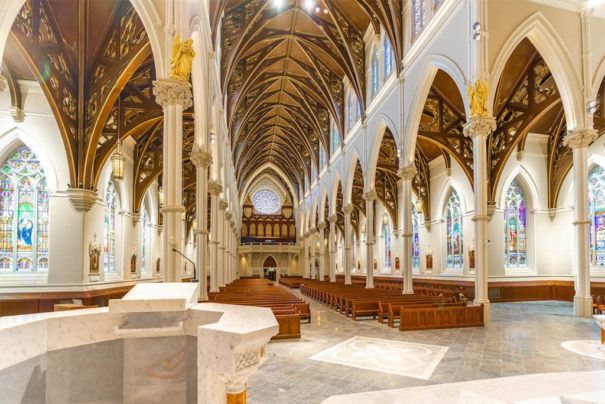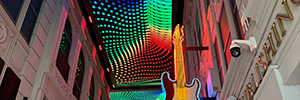The largest New England cathedral renews its sound system with Symetrix
El proyecto llevado a cabo en la catedral de Santa Cruz ha incluido una nueva iluminación Led y un complejo sistema de sonido con procesadores de señal Symetrix en su núcleo.
The Catedral de la Santa Cruz ha dominado el vecindario Sudeste de Boston desde su construcción, tras la Guerra Civil. Con una capacidad de 1.700 asientos y un techo que alcanza los 24 metros, es la iglesia católica romana más grande de Nueva Inglaterra y la sede central de la Arquidiócesis de la ciudad.
En la primavera de 2017, la catedral se embarcó en su primera renovación importante, incluida una nueva iluminación Led y un complejo sistema de sonido con procesadores de señal Symetrix en su núcleo. Two years later, la catedral ha reabierto sus puertas.
El nuevo sistema de sonido ofrece diversas entradas y salidas, que se transportan a través de una red Dante para facilitar las señales de movimiento alrededor de este edificio de gran tamaño. Dos DSP Symetrix Radius NX gestionan estas señales, con una unidad dedicada al procesamiento de entrada y la otra manejando demoras a los altavoces ubicados en la catedral.
El diseñador de sistemas Evan Landry, presidente y director de tecnología de Landry Audio, Division of CommLink Integration, consideró que la versatilidad del Radius NX es importante para satisfacer las necesidades del sistema de la catedral.
“El Radius NX ofrece una gran flexibilidad en términos de procesamiento, especialmente con la Super Matrix, que se procesa en su propio chip Sharc. También tenemos la capacidad de hacer entradas y salidas lógicas, que es muy útil para encender y apagar cosas en el rack de procesamiento y esencial para silenciar el sistema de audio en caso de una señal de cierre de alarma de incendio”, afirma Landry.
El sistema actualmente proporciona 32 input channels, y el Radius NX ofrece módulos de filtro de paso alto y ecualizador británico en cada canal de entrada.
Ocho canales de micrófonos inalámbricos son enviados por dos receptores digitales de cuatro canales Shure ULXD4Q. Otros ocho canales de micrófonos con cable para el coro se enrutan a dos placas de pared habilitadas para Atnte Tech unDX4I Dante compatibles con PoE, cada una tiene cuatro entradas de micrófono/línea con preamplificadores y alimentación Phantom.
Una interfaz en red Dante Attero Tech unD4I-L recibe la señal del micrófono de cuello de cisne que reside en el púlpito.
El unD4I-L tiene cuatro canales de entradas de micrófono/línea y cuatro canales de E/S lógica. La lógica se utiliza para detectar una estera de presión en el púlpito. La ganancia del micrófono aumenta en 5 dB en el Radius NX cuando se pisa el tapete y se retira cuando el altavoz se baja del tapete. Esto aumenta la señal para los altavoces con voces suaves, mientras evita la retroalimentación cuando no hay nadie en el púlpito.
Se hicieron provisiones para cuatro entradas de micrófonos de altar, pero aún no se han necesitado. De manera similar, un expansor de E/S analógico, habilitado para Symetrix xIO 4×4 Dante está instalado en el coro.
En el lado de salida, el sistema alimenta una matriz de líneas MicroBeam 64 a medida, más 18 matrices de líneas Innovox a lo largo de las columnas de soporte a través de la catedral: 16 en el área de la nave principal y una en cada uno de los transeptos.
La amplificación PowerSoft impulsa todos los altavoces. Cada una de estas unidades requiere su propio tiempo de retraso para sincronizar todo el sistema.
Acomodar todos estos tiempos de retraso se convirtió en la tarea del segundo Radius NX, y el número de salidas discretas requeridas se resolvió instalando tarjetas de salida analógica de 4 canales en las ranuras opcionales de ambos procesadores Radius NX, así como agregando un Symetrix xOut Expansor de 12 Analog outputs.
Se utilizan dos controladores para mezclar y controlar: A tablet Microsoft Surface que ejecuta una pantalla de interfaz de usuario programada por Landry en el software SymView, y un controlador de pantalla táctil Symetrix T-5.
“Tener una pantalla táctil es realmente útil. Es programable, por lo que cuando alguien cambia de opinión, como sucede a menudo con nuevos proyectos, podemos agregar un control de volumen, For example, con solo un cambio de programa. No tenemos que instalar otro hardware ”, relata Landry.
Landry puede hacer cambios o solucionar problemas del sistema de forma remota iniciando sesión a través de una PC Nook en el rack de procesamiento.
El sistema de micrófono de RF de la catedral está configurado como tres zonas separadas y emplea dos antenas de aleta de diversidad de lugar de RF y dos Shure UA864, que se envían a un combinador de antena de zona de RF 4.
Un estudio de transmisión totalmente equipado en el sótano genera contenido para televisión y transmisión por Internet y alimenta a la red de televisión católica, con sede en Watertown, a 10 millas de distancia.
Uno de los procesadores Radius NX alimenta señales a través de la red Dante, a través de un conmutador Luminex, a la consola Yamaha QL1 del estudio. A partir de ahí, el audio del programa se mezcla y transmite con vídeo desde las instalaciones de transmisión de la catedral, hasta una fibra óptica colocada en la torre del edificio y un transmisor de microondas que los envía al edificio John Hancock cerca de la Plaza Copley de la ciudad.
You liked this article?
Subscribe to us RSS feed And you won't miss anything.















